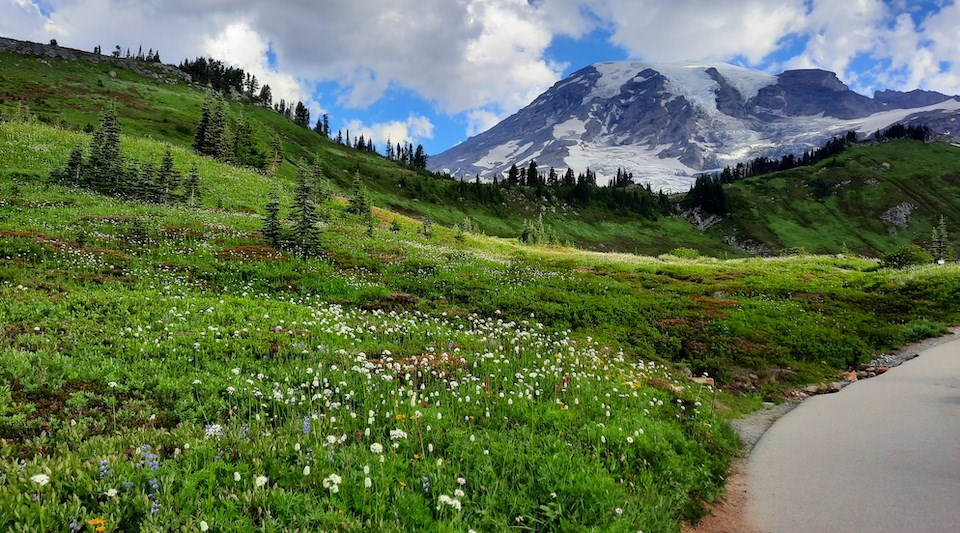
NPS/A. Spillane Photo Many visitors come to Mount Rainier National Park because of its world-famous subalpine meadows. In summer, meadows are filled with colorful displays of wildflowers, which bloom profusely during the short growing season. Meadows in the fall shine with red, yellow, and gold autumn foliage. These meadows inspired the name “Paradise”, an area that has become one of the park’s most popular destinations. However, subalpine plants live by thin margins, facing fierce competition for resources and enduring long winters and harsh conditions. After surviving all this, their greatest threat may be the millions of visitors coming to appreciate them. By law, hiking or pedestrian traffic is restricted to the trail in the following areas:
ALL subalpine areas are delicate and see increased visitation every year. Even in areas not specifically listed, please practice Leave No Trace and STAY ON THE TRAIL to protect these unique ecosystems. 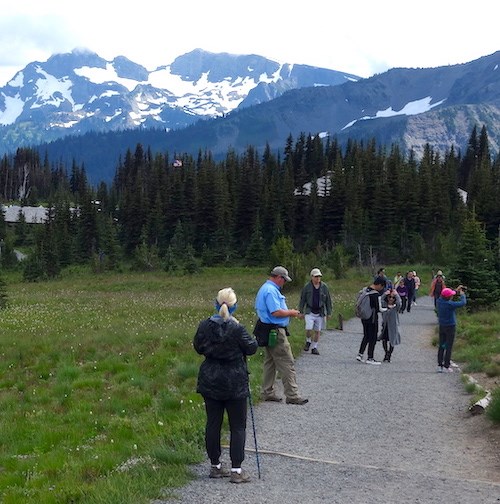
NPS Photo Cumulative EffectsSubalpine areas, such as Paradise and Sunrise, receive the pressure and impact of up to four million feet per year (the park has approximately two million visitors annually), much of it concentrated within the same visitation corridors. It is not just your feet, but the cumulative daily effect of yours and many others that takes a serious toll on subalpine plants. 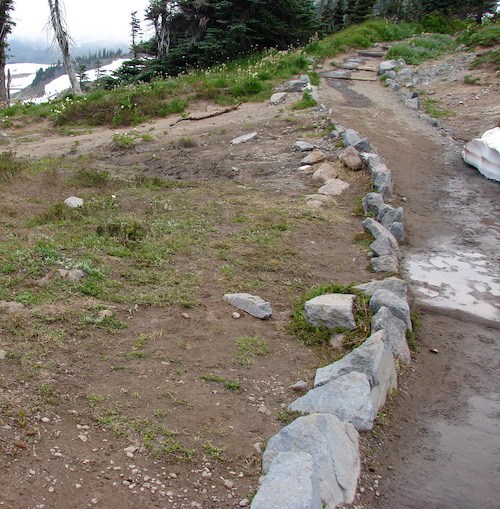
NPS/S. Redman Photo Chronic MisuseSubalpine soil is fragile, friable, and easily worn. Off-trail travel is destructive and erodes the land, creates unsightly social or shadow trails, widens trail corridors, deepens grooves, and perpetuates landscape scars. Trampled soil can be packed too hard to support plant growth. Social trails incentivize others to follow and unintentionally spread the damage. 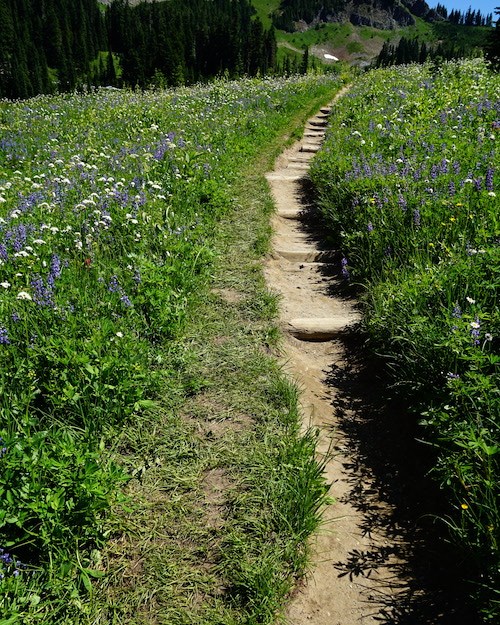
NPS Photo A Short Growing SeasonThe wildflowers are beautiful at Mount Rainier. Each year, they struggle to emerge from ground largely snow-covered for the majority of the year. Their short individual life spans measure in just weeks each summer. During those brief moments, wildflowers must gather all the energy and power from the sun they need to ensure their return. They must grow and produce seeds. Their roots take in nutrients. They serve as food sources to their pollinating partners and to other subalpine animals.
Then their ability to return and to sustain life in their mountain home becomes diminished or permanently removed. 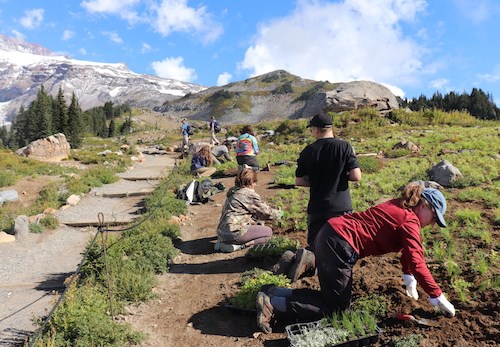
NPS/I. Metzen Photo Join the Mount Rainier CommunityPlease join others in helping subalpine meadows thrive at Mount Rainier. No one means to be destructive. Unintentional damage is still damage. Know and develop good preservation habits. Learn to recognize when your feet are wandering from the established trail and onto plant life. Keep wildflower communities healthy and beautiful by remaining on the trail. Future generations can then appreciate the experience you have left for them to enjoy. Transcript
Ecological Restoration: A Season at Mount Rainier Film Transcript
Will Arnesen (WA): The reason for an Ecological Restoration program here at Mount Rainier National Park is basically to preserve the natural ecosystem as it is without human impacts being put on the landscape. In general, simply put two ways that we commonly see impacts on a landscape here is introduction of non-native plants- invasive species- as well as then just our effects of using the landscape. One of the most common ways is off-trail travel- basically just going off that trail impacting the vegetation; and because of how many visitors we have at the park you’ll have that impact happen quite quickly. WA: Well, right now we’re in middle of May, and all of the production that’s happening in the greenhouse is internal. Seeds are being brought out, being sown on seed flats, and then staged inside the greenhouse; being kept moist. Course now they’re receiving the light, and it’s in a temperature controlled environment. You’re going to get those seedlings to pop up on a seed tray. Then the transplant is going to happen, and they’re going to tease all those plants out and get them put into pots. In essence, always trying to get one plant per pot. You’re going to have those pots then once they’ve been established, they’re going to start growing and be brought outside. And they’ll be stored outside and continue growing out here. They will be underneath the shade structure here as well as in the back, depending on kind of what their exposure is. Evan Hayduck (EH): I’m Evan Hayduck. I’m the crew lead here at the greenhouse. This is the transplanting process here. We’re taking the seeds that were sowed about a month ago, teasing them into individual plants and putting them individually into pots. There’s forty-nine pots per flat, and we’re doing about eighty-five thousand plants this year. So, those will go into the greenhouse for about a week to let them get a start on life and then we’ll take them outside and keep them watered and look for any fungus or bugs that might be growing on them. Just general maintenance after that. WA: Ways that we commonly see impacts on a landscape is introduction of non-native plants- invasive species. So exotic plant removal in this park pretty much for a crew season is June through late August, maybe some work in September. So we start low elevation and work uphill. In general, all of the exotic plants that we’re controlling are along our highways. Thankfully, it appears that the wilderness is pretty clean. The other part of that is that you’re either uphill or downhill usually in this park and your plants- the exotic plants- they don’t know uphill or downhill. As a person who needs to come in and control it, you look over that slope and you realize that the plants are hundreds of feet down either a very steep slope or possibly off a cliff and that doesn’t stop us as a crew. The Restoration program definitely takes advantage of doing rappel work in the park. In a number of spots we’ll rappel off of potentially cliffs, going down, chasing those plants down there. [garbled radio communication] WA: We definitely with the Restoration program use helicopters. It’s definitely one of these essential tools in certain scenarios that we have to take advantage of. The helicopter allows us to move a large amount of material in a short amount of time. You can image at Mount Rainier that many of the locations that we might be planting at might be remote and even if they’re not remote, they might be a mile and a half to two miles on a trail. So an area like Paradise even doesn’t necessarily feel very remote because you can see the work site, it’s a mile and a half to two miles out on a trail that we might be working, and it’s all potentially uphill. One flat- one tray of our plants, forty-nine pots, weighs about twenty-three pounds. You start adding up how much- you know forty-nine plants is twenty-three pounds, but we’re going to move forty thousand plants to the site, and you can start quickly figuring out how much weight that’s going to be and how much time. So basically the helicopter comes into to do that, to move the plants into the work site, to get it established; and to do it in a short time because the other part of that too is that getting our plants out there, the staging and movement of these plants, is they are living plants. We need to get them out there, we need to treat them accordingly as a living plant. But yeah the helicopter is an essential component to I imagine any park that is dealing with remote locations. WA: The Restoration program finished this year with roughly thirty thousand plants at Paradise. It was an eighty thousand plant year though. We did, well, we were planting eighty thousand plants but the greenhouse is very successful and they grew us an extra five thousand to plant, which we did. So, approximately eighty-five thousand plants were grown this year and planted, fifty thousand of those being over at Sunrise. Every plant that goes into the ground is going to be watered until end of season, either which is going to be rainfall, and then eventually snow. If we’re not getting the rain, it’s all hand-watering and we’re going to keep watering them weekly and so there’s a large element of work there, cause you’re trying to plant, but every time you’re watering you’re basically taking people out of the role of planting. So it’s a tradeoff. Going into September allows us to get that rainfall and keep the plants very healthy that way. Once we go to snow, snow is a blessing to the plants as well, not to the work. It’ll shut us down, if we get too much snow, we’re done. The snow will stop our season. It’s what begins our season and ends our season. But as far as the plants, we have a ninety percent or better success rate with the vegetation that we plant. Remember they’re all native plants, they all originally would have been here in time, from parents that live right next to the site, perennial stock. So they’re very well suited to the area and once the snow hits, it’s basically just sending them into a dormancy. They’re treating it like any of the native plants in the area, and all the native plants around us survive, and these plants we’re planting follow the exact same rules so they survive just as well. After that year of planting, the year that we plant them, we never water them again, and we don’t do anything with them, they’re just now part of the natural, native landscape, and that ninety percent or better success rate persists. The only way we loose them, and we loose them very quickly, is if we get repetitive use again. If for some reason, whatever the factor was causing off-trail travel, causing the social trial, that impact to happen the first time, isn’t stopped, we’ll loose a planting within the next year- you’ll see an immediate loss of species; and then maybe you know the second year after planting, you’re noticing that most of your plants are again dead, that you’re going back to a bare-ground impact. WA: Anything over eighty thousand plants a year, as the program is now, couldn’t be accomplished without the effort of volunteers. We’ll have easily on a weekend in September, we’ll have volunteers, maybe a good weekend, a big number, would be a hundred plus volunteers- we do have those weekends, and we have them repetitively, season after season- and it’s quite easy on a day like that to plant eighteen to twenty thousand plants in one day. And when you’re looking at the numbers and you’re saying you’re trying to get fifty thousand, like we did this year at Sunrise, planted and you can do twenty thousand in one day with volunteers it’s a tremendous amount of help. I always remind all of the volunteers, both for the education volunteer side of it as well as those who came out you know just to get some hard work and to spend many hours during the day, is that the vegetation that they plant, the plants they plant, stay; and if we’ve done our job right as a program, we’ve picked an area that we can protect and vegetation is going to persist and potentially they should be able to come back you know fifty years from now and see that same vegetation there, see the same plants growing, and I think that’s a huge reward for a lot of our youngest volunteers to think about, you know they can come back and see that. And we’ve had school groups come through and some of the students coming back for their second or even third year, and they’ll go pick out the plants that they planted the year before, and it’s great because they can actually see that I was telling the truth that their plants survive and actually live. So, that’s pretty rewarding but they’re also kind of becoming stewards of the mountain, you know, of these resources, and I think they carry that with them.
Visit our keyboard shortcuts docs for details
Follow Mount Rainier's Ecological Restoration program through its season, from growing native seedlings in the greenhouse to planting in the fall at Sunrise and Paradise. The Ecological Restoration program also controls invasive plants in the park, and uses everything from rappel work to helicopters to protect the natural vegetation of Mount Rainier National Park and minimize human impact. |
Last updated: October 24, 2024
